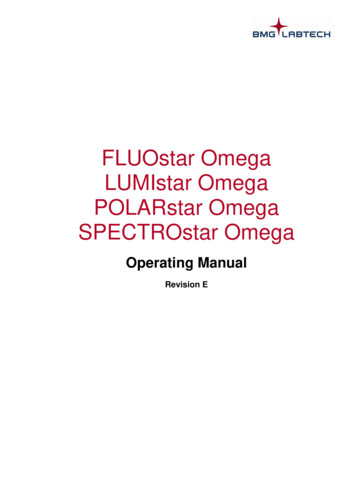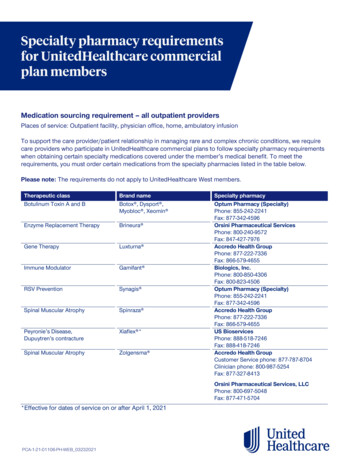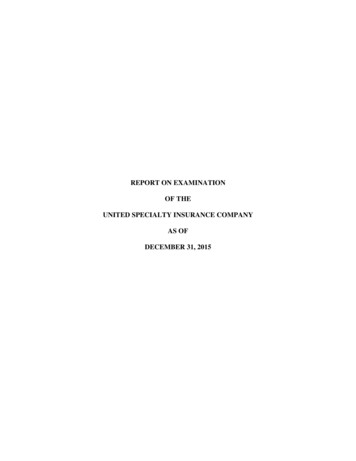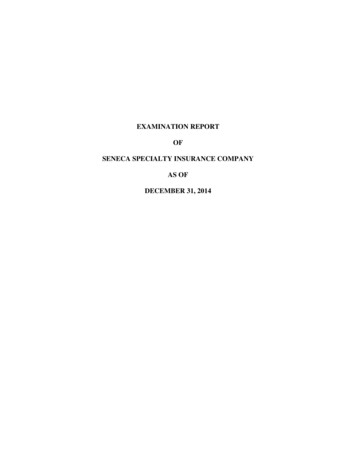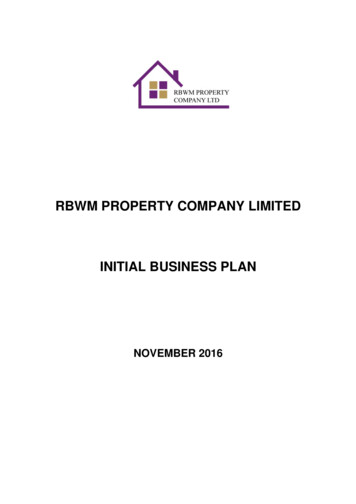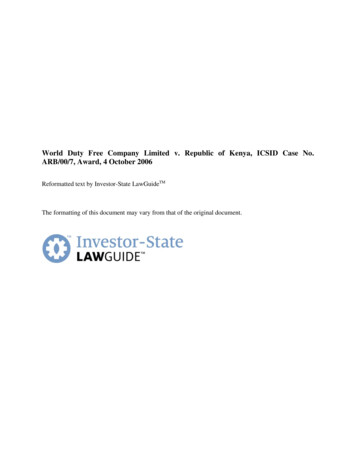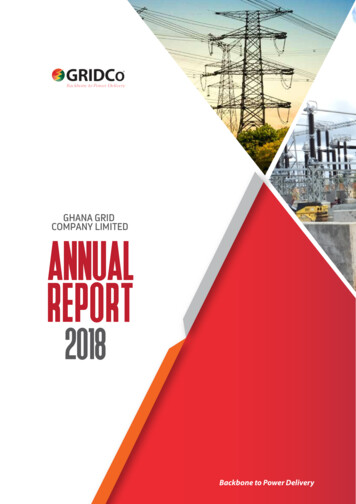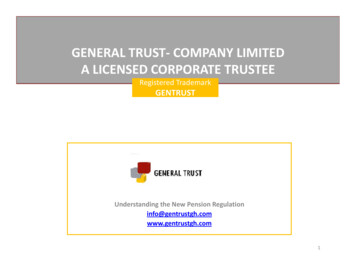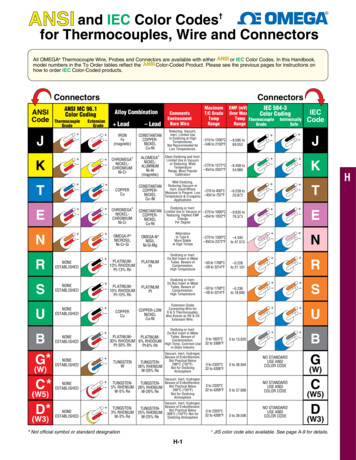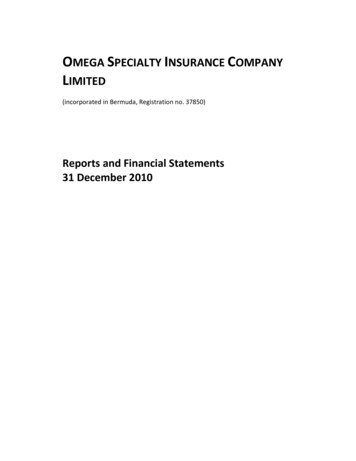
Transcription
OMEGA SPECIALTY INSURANCE COMPANYLIMITED(incorporated in Bermuda, Registration no. 37850)Reports and Financial Statements31 December 2010
OMEGA SPECIALTY INSURANCE COMPANY LIMITEDCONTENTS2.DIRECTORS’ REPORT8.STATEMENT OF DIRECTORS’ RESPONSIBILITIES9‐10.INDEPENDENT AUDITORS’ REPORT11‐12.PROFIT AND LOSS ACCOUNT13‐14.BALANCE SHEET15 ‐30.NOTES TO THE FINANCIAL STATEMENTSDIRECTORS AND ADVISERSDIRECTORSAUDITORSRichard PextonJames BryceRobin Spencer‐ArscottAndrew StapletonErnst & Young Ltd.3 Bermudiana RoadHamilton HM 11BermudaSECRETARYBANKERSMelanie SaundersHSBC Bank Bermuda Limited6 Front StreetHamilton HM 11BermudaREGISTERED OFFICE4 Par‐la‐Ville RoadHamilton HM 08Bermuda1
OMEGA SPECIALTY INSURANCE COMPANY LIMITEDDIRECTORS’ REPORTThe directors present their report on the affairs of the Company, together with the audited financial statements, ofthe Company for the year ended 31 December 2010.PRINCIPAL ACTIVITIES AND BUSINESS REVIEWThe Company was incorporated under the laws of Bermuda on 26 January 2006 and was authorised as a Class 3insurer. With effect from 1 January 2009, the Company re‐registered as a Class 3B insurer. The Company has beenassigned a financial strength rating by AM Best of A‐ (Excellent). The Company is a wholly owned subsidiary ofOmega Insurance Holdings Limited (the ultimate parent company for the “Omega group”), which is incorporated inBermuda.The Omega group’s key operating activities are as follows: the management of Lloyd’s Syndicate 958 (“the Syndicate”) which underwrites insurance and reinsurancebusiness on behalf of the members of the Syndicate across a range of classes of business but focussing onshort‐tail lines; the ownership of Omega Dedicated Limited, which is a member of the Syndicate owning a 40.5% share ofits capacity for the 2011 year of account (38.8% for the 2010 year of account and 16.4% for the 2009 yearof account); the ownership of Omega US which has underwritten a growing excess and surplus lines business in the USsince 2008; and the ownership of the Company through which the Group has underwritten a growing reinsurance book ofbusiness with other insurance companies globally.The Company’s key activities are as follows: the underwriting of the growing reinsurance book referred to above. the quota share reinsurance of the Syndicate’s gross whole account (20% for the 2010 and 2009 years ofaccount); the quota share reinsurance of the majority of business underwritten by Omega Dedicated through theSyndicate; and the quota share reinsurance of 50% of the Omega US net whole account; andThese quota share contracts have been renewed for the 2011 underwriting year.SYNDICATE 958 RESULTSAs a result of these activities the Company derives a significant proportion of its income from the Syndicate and theresults of the Syndicate are directly linked to the performance of the Company.With the closure of the 2008 underwriting year of account at 31 December 2010, the Syndicate continued into its29th year its track record of unbroken profitability, reflecting a 3.5% return on Syndicate capacity. The benefit ofthese profits, through the contracts above, was reflected in the Company’s accounts across 2008, 2009 and 2010.2
OMEGA SPECIALTY INSURANCE COMPANY LIMITEDThe 2009 year of account has been significantly affected by the Chilean earthquake in February 2010 and to a lesserextent, the Deepwater Horizon incident. As a result the Syndicate return on capacity has been forecast between 5%and 10%. The effects of the profitability of the 2009 year of account have been reflected by the Company acrossthe 2009 and 2010 financial years in accordance with the earnings patterns of the underlying premium and thetiming of the incidence of catastrophe losses experienced. This resulted in a strong profit being recognised in the2009 calendar year and a loss being recognised on the 2009 year of account in 2010.The 2010 year of account was, during 2010, characterized by a deteriorating rating environment and resultingincreased attritional loss ratios along with catastrophe events in New Zealand and Australia, coupled with acontinued challenging investment environment.THIRD PARTY REINSURANCE BUSINESSThe Company underwrites third‐party reinsurance business through the Bermuda reinsurance market. The third‐party reinsurance portfolio is primarily focused on US and international property catastrophe treaty reinsurance. Italso includes property risk excess treaty reinsurance, property insurance and marine and aviation reinsurance.The US catastrophe book has been predominantly made up of regional and multi‐regional business but there areopportunities with regards to some of the nationwide accounts where capacity pricing has been a little morepositive. The results of the US catastrophe book have not been significantly impacted by US losses, notwithstandingthe industry experience showing US 12 billion of market losses, as estimated by PCS (Property Claims Service).The international catastrophe market has experienced an extreme year of losses with the Chile and New Zealandearthquakes and Australian floods which have impacted significantly on the results of the Company through theretrocessional account on both a gross and net basis. Accordingly we have now significantly reduced this account.We have also reviewed the reinsurance program taking into account the level of recoveries on the 2010catastrophe losses in order to improve efficiency and effectiveness.In 2010 the Company underwrote gross written premium of US 65.2 million (2009: US 63.0 million) through thissource. The combined ratio increased to 129.9% from 49.3% in 2009 due to the increased incidence of internationalcatastrophic events during the year.OMEGA US RESULTSOmega US is the Group’s US underwriting platform and is based in Schaumberg, Illinois. Omega US was capitalisedin late 2006 with US 50 million by way of a share placing by Omega Group and is currently rated A‐ (Excellent) byA.M. Best. It is incorporated and licensed by the state of Delaware and underwrites property and casualtyinsurance on an excess and surplus lines basis throughout the United States. Excess and surplus lines is a segmentof the US insurance market tailored to specialty risks that fall outside of the standard criteria used by US admittedinsurers. To date Omega US has been granted eligibility to underwrite business in 42 US jurisdictions, and continuesto seek eligibility in the remaining US jurisdictions.The business commenced underwriting in the first quarter of 2008 and is developing a portfolio of business similarin shape to the property insurance account written by Syndicate 958. It targets small to medium‐sized commercialbusinesses and seeks to underwrite in those geographic areas in the US where it avoids clashing with Syndicate958’s property catastrophe account. Omega US complements Syndicate 958 by sourcing business through existingagents, together with distribution channels not ordinarily available to Syndicate 958.Gross written premium to the Company increased by 27.1% to US 23.0 million in 2010 (2009: US 18.1million). Gross earned premium increased by 68.5 % to US 20.9 million (2009: US 12.4 million). With ongoinggrowth, the cost base will continue to become more efficient and loss variability will reduce, both of which havehelped contribute to a lower combined ratio in 2010 – a trend we see continuing in 2011.3
OMEGA SPECIALTY INSURANCE COMPANY LIMITED2010 was another challenging year for the US excess and surplus lines market, which incurred further ratereductions, increased appetite from the admitted market for non‐standard business; and the economic effects ofthe recession on our risk base. However, Omega US enjoyed steady growth with many of its general agents, and weexpect this to continue in 2011. Further, poor investment yield ensures that emphasis remains firmly fixed onunderwriting profit. Omega US continues to work on obtaining its remaining surplus lines licenses, which will alsosupport additional growth going forward.POST BALANCE SHEET EVENTS AND OUTLOOKSubsequent to the year end the earthquake in Christchurch New Zealand in February 2011 has had a material effecton the 2010 year of account results, although this effect is not reflected in these accounts since its occurrence wasafter 31 December 2010. Whilst there is a significant degree of uncertainty around the ultimate costs of theseclaims to the industry and the Company, the Company’s initial estimate of losses arising from this earthquake is 8.4m net of reinsurance recoveries and reinstatement premiums.During January 2011 significant flooding occurred in Queensland, Australia as a result of sustained heavy rainfall.This is expected to result in significant losses to the insurance market. The Group estimates that the event willresult in net insurance claims to the Company of approximately 7.2m in 2011 although there is significantuncertainty as to the ultimate cost of such claims.On 12 March 2011, a major earthquake hit Japan. Whilst there is a significant degree of uncertainty around theultimate costs of claims to the industry and the Company from this event, the Company’s estimates that its lossesarising from this earthquake and tsunami event are 22.8m net of reinsurance recoveries and reinstatementpremiums.The Omega group will continue to manage Syndicate 958. As noted above, the Company’s key reinsurancecontracts with group companies and Syndicate 958 have been renewed for 2011. The Company’s reinsurance ofOmega Dedicated Limited will increase with the increase of that company’s share of syndicate capacity from 38.8%for the 2010 year of account to 40.5% for the 2011 year of account.RESULTS, DIVIDENDS AND CAPITALThe results for the year ended 31 December 2010 are shown in the profit and loss account on pages thirteen andfourteen of the financial statements. The loss on ordinary activities for the year was US 27.7m (2009: profit ofUS 44.5m).Subsequent to year end the directors approved a return of contributed surplus of 9.0m to be paid in 2011 (2009:US 17.0m). Dividends paid during the year were US 31.610m (2009: US 4.5m).DIRECTORSThe directors who held office during the year were as follows:Richard PextonJames BryceRobin Spencer‐ArscottAndrew StapletonPenny James (ceased to be a director 9 March 2011)Walter Fiederowicz (ceased to be a director 12 March 2010)Nick Warren (ceased to be a director 12 March 2010)Richard Tolliday (ceased to be a director 22 April 2010)AUDITORS4
OMEGA SPECIALTY INSURANCE COMPANY LIMITEDThe Company will reappoint Ernst & Young Ltd. (Bermuda) as auditors of the Company.RISK MANAGEMENTThe Omega group operates an integrated risk management framework across its global entities. Where possibleand appropriate (taking into account possible conflicts of interest) risks are managed on a group‐wide basis with allkey operating subsidiaries (including the Company) represented in relevant risk committees.The Group Risk Management Framework is described in detail in note 21.2010 highlights:We have continued to build our risk and control framework to address the material risks faced by the GroupIn 2010, in addition to upgrading the separate Compliance, Internal Audit and Actuarial functions, Omega’s riskmanagement processes were enhanced with the development of a dedicated risk management function for theGroup. The risk management function is also responsible for developing the risk management framework across alllocationsThe Group has subscribed to AIR catastrophe modelling capability to assist the management of main catastropheexposures2011 priorities:A key priority for 2011 will be to embed the procedures for risk assessment and reporting into the businessprocesses throughout the Group.As required by Solvency II, progress has been made with regard to developing an Own Risk and SolvencyAssessment (ORSA) for Omega Underwriting Agents Limited (in relation to Syndicate 958) which will be developedfurther in 2011, including the integration of a risk management framework within key areas of the business. Thiswill be linked to the Bermuda requirement to prepare the Commercial Insurer’s Solvency Self Assessment (CISSA)for the Group, which will cover all the subsidiaries in the Group.Group risk functionDuring 2010 Omega established a Group Risk Management function with responsibilities for the risk and controlframework across the Group and each of the operating entities. This function reports into the Group Board andAudit Committee, via the Chief Operating Officer, but also has local reporting lines to the entity boards and theOUAL Risk Committee. The Group Audit Committee has specific responsibilities for monitoring and approving therisk management process across the Group, as reflected in its Terms of Reference and Membership. OUAL also hasa dedicated Risk Committee with oversight of the full risk management process for OUAL and Syndicate 958. Riskreporting is being developed, including risk dashboards, for the Group and subsidiary boards, and this will continueto be enhanced in 2011.The OIH board retains responsibility for the risk management throughout the Group, including determining riskappetite and setting risk policies; however the Board delegates to various committees for reviewing many aspectsof the ‘Three lines of defence’. This approach to governance is demonstrated by the following model, with themain focus being to ensure that appropriate controls are embedded in the day to day management of the business,while also maintaining independent risk, compliance and internal audit functions to support the second and thirdlines of defence.5
OMEGA SPECIALTY INSURANCE COMPANY LIMITED1st line of defence2nd line of defence3rd line of defenceDay to day risk managementand controlRisk oversight, policy andmethodologiesIndependent AssuranceOIH BoardDelegates toDelegates toDelegates to(E.g.)(E.g.)(E.g.)Reserving CommitteeInvestment CommitteeAudit CommitteeActivity iscarried outbActi
insurance on an excess and surplus lines basis throughout the United States. Excess and surplus lines is a segment of the US insurance market tailored to specialty risks that fall outside of the standard criteria used by US admitted insurers. To date Omega US has been granted eligibility to underwrite business in 42 US jurisdictions, and continues to seek eligibility in the remaining US .
